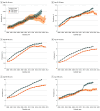Incidence, Prevalence, and Survival of Prostate Cancer in the UK
- PMID: 39298169
- PMCID: PMC12315704
- DOI: 10.1001/jamanetworkopen.2024.34622
Incidence, Prevalence, and Survival of Prostate Cancer in the UK
Abstract
Importance: Incidence, prevalence, and survival are pertinent measures to inform the management and provision of prostate cancer care.
Objective: To calculate the incidence, prevalence, and survival rates for prostate cancer in the UK from 2000 to 2021.
Design, setting, and participants: This population-based cohort study uses routinely collected primary care data from the UK. Male patients aged 18 years or older with at least 1 year of history registered in Clinical Practice Research Datalink (CPRD) GOLD or Aurum were included. Data were analyzed from January 2023 to March 2024.
Main outcomes and measures: Prostate cancer incidence rates (IR), period prevalence (PP), and 1-, 5-, and 10-year survival after diagnosis between 2000 and 2021, stratified by age and calendar years.
Results: This study included 64 925 and 133 200 patients with prostate cancer in CPRD GOLD and Aurum, respectively, with a median age of 72 (65-78) years. The overall IR of prostate cancer was 151.7 (95% CI, 150.6 to 152.9) per 100 000 person-years in GOLD to 153.1 (95% CI, 152.3 to 153.9) per 100 000 person-years for Aurum and increased with age. The incidence of prostate cancer increased from 109 per 100 000 person-years in 2000 to 159 per 100 000 person-years in 2021. Peaks of incidence occurred in 2004 and 2018, before a decline in 2020. PP increased 3.5 times over the study period for both databases, from 0.4% in 2000 to 1.4% in 2021. IR and PP were highest in those aged 80 to 89 years. Median (95% CI) survival was similar in both databases (GOLD: 10.9 [95% CI, 10.7-11.1] years and Aurum: 11.1 [95% CI, 11.0-11.2] years). Survival at 1, 5, and 10 years after diagnosis were 93.4% (95% CI, 93.2%-93.6%), 71.8% (95% CI, 71.4%-72.2%), 53.2% (95% CI, 52.6%-53.7%) in GOLD and 93.9% (95% CI, 93.7%-94.0%), 72.7% (95% CI, 72.5%-73.0%), 53.7% (95% CI, 53.3%-54.1%) in AURUM, respectively. Survival increased over time: 1-year survival was 94.8% (95% CI, 94.5%-95.2%) in those diagnosed between 2015 to 2019 compared with 90.8% (95% CI, 90.2%-91.3%) from 2000 to 2004; 5-year survival improved from 65.3% (95% CI, 64.4%-66.3%) from 2000 to 2004 to 75.3% (95% CI, 74.4%-76.3%) in 2015 to 2019.
Conclusions and relevance: In this population-based cohort study, incidence and prevalence increased with older age, with high survival rates reflecting a high burden of disease, particularly in the management of cancer survivorship in an aging population. Health care systems should consider this when managing the increasing numbers of people with prevalent prostate cancer.
Conflict of interest statement
Figures




References
-
- NICE Clinical Knowledge Summaries. What should I advise about screening for prostate cancer? National Institute for Health Care Excellence. Accessed August 13, 2024. https://cks.nice.org.uk/topics/prostate-cancer/diagnosis/screening-for-p...
-
- Prostate cancer risk management programme: overview. Public Health England. Accessed August 13, 2024. https://www.gov.uk/guidance/prostate-cancer-risk-management-programme-ov...
-
- NHS England. Checks for prostate cancer hit all-time high on back of NHS and charity awareness campaign. National Health Service. Accessed January 4, 2024. https://www.england.nhs.uk/2022/05/checks-for-prostate-cancer-hit-all-ti...
Publication types
MeSH terms
LinkOut - more resources
Full Text Sources
Medical
Miscellaneous

